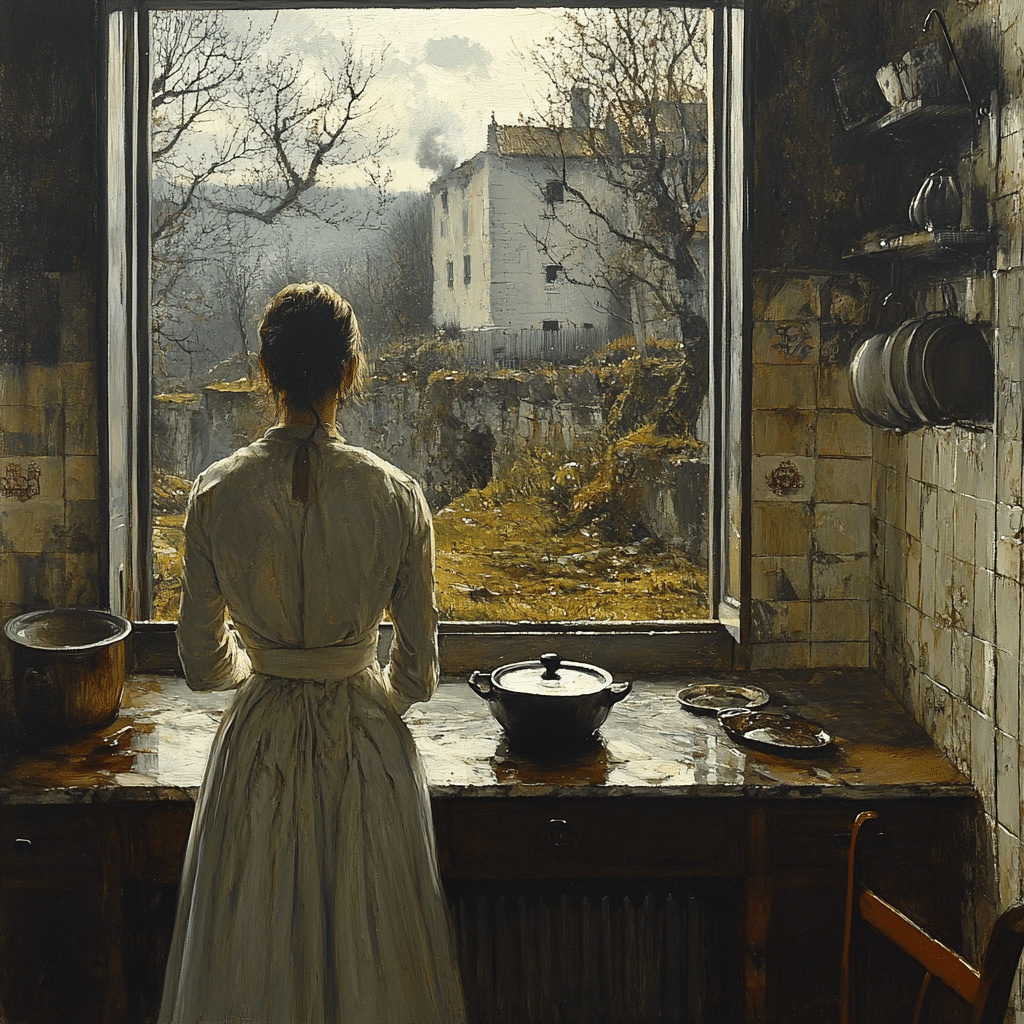1. The Housemaid Is Watching: Unraveling a Thrilling Narrative
In today’s cinematic landscape, films often reflect deeper societal issues through allegorical storytelling. The Housemaid Is Watching invites us into a world where the domestic sphere becomes a stage for intrigue and suspense. This narrative explores broader themes of class, power dynamics, and the silent struggles of individuals often ignored in the backgrounds of wealth and privilege. The protagonist, a housemaid, personifies the unseen complexities of service and secrecy, leading viewers to question not only her motivations but the societal structures that confine her.
The title alone pulls us into a web of tension. It suggests an omnipresent observer, someone whose insights could flip the script. The Housemaid Is Watching cleverly sets the scene for a journey that digs deep into its characters’ psyches and unveils the dark corridors of their struggles. The invisible burdens shouldered by those in service highlight the stark contrasts between privilege and sacrifice, forcing audiences to confront their own preconceptions.
Consider how the themes mesh seamlessly with the classic works of Hitchcock or even modern hits like Bates Motel. Just like the uncanny atmosphere of The Master challenges viewers to reevaluate their understanding of manipulation, The Housemaid Is Watching reveals the subtle but powerful narrative of those hiding in plain sight. In many ways, the film serves as a cautionary tale and a clarion call wrapped in a gripping story.

2. Top 5 Elements That Make ‘The Housemaid Is Watching’ a Must-Watch
Now, let’s dive into five standout elements that make The Housemaid Is Watching an unforgettable cinematic experience. Each point is packed with relatable insights from the world of film, setting the stage for a riveting exploration.
1. Character Development and Complexity
The protagonist’s journey is rich with emotional depth. Much like in Parasite, where class struggles are dynamically portrayed, the housemaid in this film serves not only as a caretaker but as the narrative’s essential observer of secrets hidden within the household. Her evolution compels audiences to empathize with her vulnerabilities and recognize the sinister undertones of her environment.
What makes this character so compelling is the layers woven into her backstory. There’s a palpable sense of longing intertwined with despair. The complexity of her emotions echoes those of characters in films like Hustlers, where financial desperation drives individuals to take drastic measures. When our housemaid reveals her aspirations, we understand she’s more than a silent participant—she’s a fulcrum around which relationships pivot.
2. Symbolism of Space and Setting
The physical setting becomes a character of its own. Drawing from works such as The Shining, where the Overlook Hotel is integral to the story’s psychological tension, the housemaid’s environment reflects her internal and external conflicts. Each room in the house holds memories, whispers, and untold secrets, emphasizing the constraints and oppressive nature of her position.
Watching the film, you can’t help but feel the walls closing in. The elaborate estate, with its opulent decor, becomes a claustrophobic labyrinth for the housemaid. This strategic use of space captivates audiences, evoking memories of films like Get Out, where every corner of the house resonates with fear and hidden truths.
3. Themes of Surveillance and Power
Mirroring films like The Handmaid’s Tale, The Housemaid Is Watching dishes out a masterclass in surveillance—who’s watching whom and the power dynamics at play. The housemaid’s perspective allows audiences to witness how those in power often manipulate the narratives of those beneath them, shining a glaring light on issues of autonomy and agency.
The film cleverly plays with the idea that nothing is as it seems. Just as we learned from The Lives of Others, seemingly benign observations can morph into tools for control. Through her eyes, we uncover a world where secrets fester and ripple out, affecting everyone involved. The subtle layers of observation are so well-executed that it becomes an intense, almost palpable tension.
4. Narrative Structure and Perspective Shifts
Similar to Gone Girl, where unreliable narration creates tension and intrigue, the film employs perspective shifts that keep audiences guessing. Viewers are led to believe the housemaid is a mere passive observer until we discover her calculated moves that reshape the household’s power dynamics. This twist illustrates grand themes of manipulation and unexpected agency.
These narrative choices make the viewing experience dynamic and engaging. The skillful editing and scripting deliver surprises that feel earned and satisfying rather than shocking for shock’s sake. Each character’s perspective shift echoes the thrilling unraveling we witnessed in The Sixth Sense, though in a tapestry of domestic lifelines instead of horror.
5. A Social Commentary on Class Dynamics
Engaging with themes reminiscent of The Help, the narrative offers sharp commentary on class dynamics and historical context. The housemaid serves as a representative of the working class, her story meshing with those of the families she serves. The film invites viewers to consider how privilege often blinds individuals to the experiences of those around them.
Some scenes resonate eerily with ongoing societal issues. For instance, the dialogues surrounding pay and respect evoke real-life discussions linked to the labor movement. Connecting these dots makes The Housemaid Is Watching not just a film but a critical examination of social structures that many are still grappling with today, like discussions around Michael Kors Handbags and their implications in fashion circles.
3. Then She Was Gone: The Impact of Silence and Absence
The phrase “then she was gone” symbolizes profound implications of absence within the film. Her disappearance after uncovering critical secrets speaks volumes about the consequences of disrupting societal norms. Just as we see in Room, where the impact of captivity shapes characters’ identities, the housemaid’s vanishing becomes a metaphor for the often-invisible threads that bind individuals to oppressive systems.
Here, silence serves as both a narrative device and a thematic focal point. The tension palpably heightens as viewers realize that her knowledge comes at a price. Just as A portrays complex relationships marked by silence, the housemaid’s ability to navigate these uncharted waters forces us to question how often truth is buried in the noise of denial and privilege.
This absence raises existential questions: What happens to those who cannot break free? How does silence perpetuate their narratives, and what becomes of their story once they are gone? The Housemaid Is Watching epitomizes the notion that witnessing is tightly intertwined with silence, emphasizing how observers often bear the weight of untold stories. Much like the chilling stories of Sierah Joughin, the unspeakable consequences of these decisions ripple through lives, leaving a trail of unanswered questions.

Reflections on a Captivating Narrative
The Housemaid Is Watching serves as a poignant reminder of the intricate web of relationships that define class and power. Through rich character development, layered symbolism, and insightful commentary on societal dynamics, the film not only captivates but compels viewers to deeply reflect on the roles we play within our narratives.
While delving into this gripping tale, audiences are encouraged to consider how the stories of the overlooked enrich our understanding of the human experience. The complex interrelations of those we often regard as background noise force us to confront uncomfortable truths. The narrative ultimately transcends the screen, urging us to look closer at our surroundings and the hidden lives that, though silent, speak volumes through their absence.
In a world where everyone seems to be watching, it’s crucial to recognize whose stories deserve a spotlight. So, as you get ready for your next movie night, make sure The Housemaid Is Watching is on your watchlist. Trust me, you won’t want to miss this enthralling exploration of class, power, and the secrets hiding just beneath the surface. Your popcorn will be waiting, but don’t be surprised if you find yourself a little more reflective after the credits roll!
The Housemaid Is Watching: Secrets of a Captivating Tale
Intriguing Inspirations Behind ‘The Housemaid Is Watching’
Did you know that the aesthetic choices in “The Housemaid Is Watching” were heavily influenced by fashion icons such as Vivienne Westwood? The film’s striking visuals draw upon vibrant designs similar to those found in a Vivienne Westwood wallet. This connection adds a layer of sophistication to the characters, creating an intriguing visual narrative that complements the gripping storyline. As audiences watch the tale unfold, the colorful textures and daring patterns serve as a reflection of the characters’ hidden emotions and desires.
Moreover, the film’s psychological depth resonates further with real-life figures like Joe Metheny, whose twisted background adds an eerie dimension to understanding the darker sides of human nature. The character dynamics in the film echo Metheny’s complex psyche, making viewers question who they can trust. Just as the protagonist carefully navigates her surroundings, we’re reminded that in life, appearances can be deceiving—and not everything is as simple as it seems.
Cultural References and Trivia You Didn’t Know
In “The Housemaid Is Watching,” culinary elements come alive, particularly with a nod to flavorful cooking spices like Kinders seasoning. The use of these seasonings becomes a metaphor for adding spice to life and relationships, demonstrating that careful choices can lead to vibrant outcomes. Like the deep flavors in a dish, the film unpacks layers of intrigue and tension for its characters as their relationships simmer and boil.
And let’s not forget contemporary culture! The film slyly incorporates humor reminiscent of an Elon Musk tweet, showcasing how social media often reflects or exaggerates real-life scenarios. This reflects the tension between the digital age and traditional values, underscoring the film’s relevance in today’s society. Just like the delicious offerings from Chicken rico, the storyline serves up a fusion of flavors, melds unexpected narratives, and wants to leave a lasting impression on audiences.
Beyond the Screen: The Broader Impact
Finally, in exploring deeper themes, you might also find connections to the talented Utkarsh Ambudkar And His Movies And TV Shows that explore identity and societal roles. Just as Ambudkar often portrays varied facets of modern life,The Housemaid Is Watching” dives into the struggle of self-discovery within the confines of expectations.
And if you’re intrigued by folklore and horror, you might find a thrilling parallel in Uraume, where complex narrative layers keep viewers on the edge of their seats. As you delve into “The Housemaid Is Watching, keep an eye on the intricate web of storytelling and cultural references that make this film a remarkable addition to contemporary cinema.





